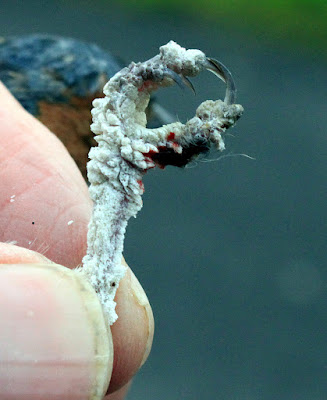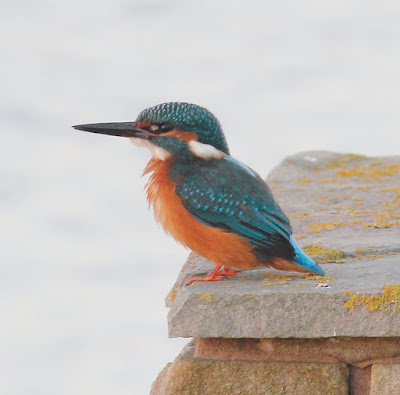There was another strong easterly this morning. Several days of east and south easterly winds have blown a few continental waifs, namely Barred Warbler and Wryneck, to this the west coast, but almost 20 miles to the south of here.
If there’s one there’s almost certainly another of the same species lurking yet unfound is my philosophy. So I set off in the opposite direction for a spot of “bush bashing” at Glasson and Conder Green, as likely place as any to try for an unusual bird or two.
On the way north I pulled in at Braides Farm where a Buzzard hovered above the sea wall until crows came along to send the Buzzard to ground level. A tight flock of 70/80 Golden Plover tore around the fields at low level before eventually settling down somewhere in the distant grass.
The path between Conder and Glasson was pretty cool and windswept. At the car park a single Siskin flew over calling but remained invisible. My lonely walk gave little of note except for sightings of a single Chiffchaff, 9 Long-tailed Tit, 4 Linnet, a good sized but very flighty team of 80/90 Goldfinch, and a group of 8 Little Egrets flying down river.
I checked a couple of quiet spots at Glasson including my regular look in Christ Church graveyard. It resembles the textbook spot in which to find a rare bird like a Hoopoe, a Wryneck or a shrike but has yet to deliver.
I was almost there as a small warbler flit through the tree tops but then called the familiar slurred “hweet” of another Chiffchaff. Nearby was the resident Robin in autumn song and just Blackbirds rather than rare warblers tucking into the autumn berries.
The church is alongside the canal towpath from where I could see lots of Swallows over the yacht basin just ahead. There’s still something like 500+ feeding and resting Swallows around and mixed in with them today 20+ House Martins.
On the water - 9 Tufted Duck, 18 Coot and the return today of a Great Crested Grebe. The grebes nest here in years when water levels are ideal and the spring and summer oblige. Not in 2015.
This was getting nowhere. It was too windy for finding warblers or much else so I drove to Conder Green to see the regular and always obliging waders and wildfowl. The counts today - 40 Teal, 7 Little Grebe, 6 Curlew, 4 Greenshank, 2 Spotted Redshank, 3 Snipe, 1 Ruff, 1 Kingfisher.
Another Bird Blog will be trying again quite soon. Please look in a day or two.
Linking today to Anni's Birding and Eileen's Saturday.
On the way north I pulled in at Braides Farm where a Buzzard hovered above the sea wall until crows came along to send the Buzzard to ground level. A tight flock of 70/80 Golden Plover tore around the fields at low level before eventually settling down somewhere in the distant grass.
The path between Conder and Glasson was pretty cool and windswept. At the car park a single Siskin flew over calling but remained invisible. My lonely walk gave little of note except for sightings of a single Chiffchaff, 9 Long-tailed Tit, 4 Linnet, a good sized but very flighty team of 80/90 Goldfinch, and a group of 8 Little Egrets flying down river.
I checked a couple of quiet spots at Glasson including my regular look in Christ Church graveyard. It resembles the textbook spot in which to find a rare bird like a Hoopoe, a Wryneck or a shrike but has yet to deliver.
I was almost there as a small warbler flit through the tree tops but then called the familiar slurred “hweet” of another Chiffchaff. Nearby was the resident Robin in autumn song and just Blackbirds rather than rare warblers tucking into the autumn berries.
Glasson Church
Robin
Chiffchaff
Blackbird
The church is alongside the canal towpath from where I could see lots of Swallows over the yacht basin just ahead. There’s still something like 500+ feeding and resting Swallows around and mixed in with them today 20+ House Martins.
On the water - 9 Tufted Duck, 18 Coot and the return today of a Great Crested Grebe. The grebes nest here in years when water levels are ideal and the spring and summer oblige. Not in 2015.
Great Crested Grebe
Glasson Dock
This was getting nowhere. It was too windy for finding warblers or much else so I drove to Conder Green to see the regular and always obliging waders and wildfowl. The counts today - 40 Teal, 7 Little Grebe, 6 Curlew, 4 Greenshank, 2 Spotted Redshank, 3 Snipe, 1 Ruff, 1 Kingfisher.
Another Bird Blog will be trying again quite soon. Please look in a day or two.
Linking today to Anni's Birding and Eileen's Saturday.
























































.jpeg)








.jpg)












